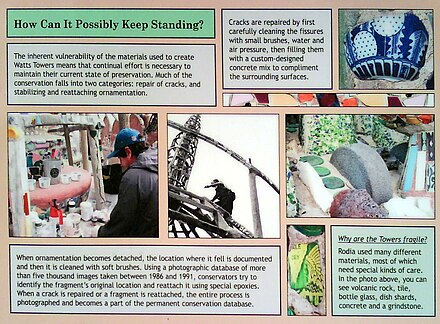Watts Towers
The Watts Towers, Towers of Simon Rodia, or Nuestro Pueblo ("our town" in Spanish) are a collection of 17 interconnected sculptural towers, architectural structures, and individual sculptural features and mosaics within the site of the artist's original residential property in Watts, Los Angeles. The entire site of towers, structures, sculptures, pavement and walls were designed and built solely by Sabato ("Simon" or "Sam") Rodia (1879 or 1886–1965),[5] an Italian immigrant construction worker and tile mason, over a period of 33 years from 1921 to 1954. The tallest of the towers is 99.5 feet (30.3 m).[6] The work is an example of outsider art (or Art Brut)[7] and Italian-American naïve art.[4][8]
The Watts Towers were designated a National Historic Landmark and a California Historical Landmark in 1990.[4][1] They are also a Los Angeles Historic-Cultural Monument, and one of nine folk art sites listed in the National Register of Historic Places in Los Angeles. The Watts Towers of Simon Rodia State Historic Park encompasses the Watts Towers site.
The Watts Towers are one-half mile (0.8 km) from the 103rd Street/Watts Towers station of the Los Angeles Metro A Line.
Sabato ("Simon" or "Sam") Rodia (February 12, 1879 (?) – July 17, 1965) was born and raised in Serino, Italy.[9][10] In 1895, aged fifteen, he emigrated to the United States with his brother.[11] Rodia lived in Pennsylvania until his brother died in a mining incident. He then moved to Seattle, Washington, where he married Lucia Ucci in 1902. They soon moved to Oakland, where Rodia's three children were born. Following his divorce around 1909, he moved to Long Beach and worked at odd jobs before finally settling in Watts in 1920.[12] Rodia began constructing the Watts Towers in 1921.
There has been some question as to what Rodia was called during his lifetime; some sources have cited that his birth name was "Sabatino" and it is disputed as to if he was called "Simon" during his lifetime. It is widely known and accepted that he was referred to as "Sam" by close friends. He appears as Samuel Rodia (and still living in Oakland) in the 1910 U.S. Census, but by the time of the 1920 U.S. Census, he had already become Sam Rodia. His surname has also been misspelled as "Rodella" or "Rodilla".[13]
He appears on the iconic cover of the Sergeant Pepper album by The Beatles (top right corner, to the left of and behind Bob Dylan).


